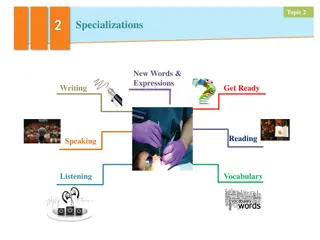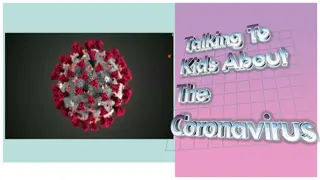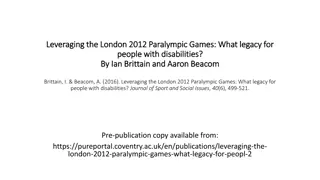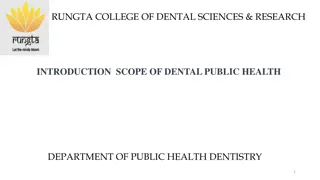Management of Developmentally Disabled Children in Dentistry
Explore specific learning objectives and essential categories for dental assistants in treating developmentally disabled children. Learn about attitudes towards disabled children, roles of dental assistants, barriers in care provision, visual impairment, and hearing loss. Dive into core domains such as cerebral palsy and childhood autism for a comprehensive understanding.
Download Presentation

Please find below an Image/Link to download the presentation.
The content on the website is provided AS IS for your information and personal use only. It may not be sold, licensed, or shared on other websites without obtaining consent from the author.If you encounter any issues during the download, it is possible that the publisher has removed the file from their server.
You are allowed to download the files provided on this website for personal or commercial use, subject to the condition that they are used lawfully. All files are the property of their respective owners.
The content on the website is provided AS IS for your information and personal use only. It may not be sold, licensed, or shared on other websites without obtaining consent from the author.
E N D
Presentation Transcript
ARC design for 100km ring Yiwei Wang, Jie Gao CEPC AP meeting, 2 Dec 2016
DA vs. Circumfence For Higgs factories, FODO cell is favorite for its high filling factor. Usually, phase advance of 60 /60 or 90 /90 is chosen for its property of aberration cancellation. If fix emittance bending angle ? per dipole and cell number ?????is fixed ??=????2?3 ?? 2 1 3 sin3? 4sin2? 2cos? 2 ? = ? ????? 2?????? = 2? chromaticity of ARC ? is fixed, but dispersion at sextupole ??will increase with a longer cell length ? ??(1 1 4sin2? Thus, the nonlinearity generated by sextupole ??? will decrease with a longer cell length ? 2sin? 2) ? = ????? tan? ??= ? 2 2 ?? 1 ? ?2? ? If fix emittance, L Dx K2 DA
DA vs. Circumfence An example by Y. Cai change circumference of ring while keep the IR
90/90 degree Eng=120 Lring=54820.48000000032 U0=- thetaC=15 thetaP=2.6 Ne=2.67 Nb=44 Ib=.0105 Pbeam=- rhoB=6200 alfap=- bxstar=- bystar=- ex=2.0935553797925138e-09 ey=0 sigxIP=- sigyIP=- ksix=- ksiy=- Vrf=3.53e+09 frf=6.5e+08 sigmaz=.002638957643199394 sigmazt=- Phom=- sigmae=.0013022977605895913 eapt=- eaptrf=- ngamma=- tbs=- Fhg=- Lmax=- Eng=120 Lring=74396.48000000458 U0=- thetaC=15 thetaP=2.6 Ne=2.67 Nb=44 Ib=.0105 Pbeam=- rhoB=9300 alfap=- bxstar=- bystar=- ex=1.98345500603251e-09 ey=0 sigxIP=- sigyIP=- ksix=- ksiy=- Vrf=2636910000 frf=6.5e+08 sigmaz=.0027049009699175197 sigmazt=- Phom=- sigmae=.0010632425947487473 eapt=- eaptrf=- ngamma=- tbs=- Fhg=- Lmax=- Eng=120 Lring=92707.19999999877 U0=- thetaC=15 thetaP=2.6 Ne=2.67 Nb=44 Ib=.0105 Pbeam=- rhoB=12090 alfap=- bxstar=- bystar=- ex=1.932695860302522e-09 ey=0 sigxIP=- sigyIP=- ksix=- ksiy=- Vrf=2259200000 frf=6.5e+08 sigmaz=.002734597171221037 sigmazt=- Phom=- sigmae=.0009324837783256101 eapt=- eaptrf=- ngamma=- tbs=- Fhg=- Lmax=- Real tune: 0.08, 0.22, -0.0718478 Bucket height dV/P0 = .0249642 Real tune: 0.08, 0.22, -0.0812613 Bucket height dV/P0 = .0249614 Real tune: 0.08, 0.22, -0.0892573 Bucket height dV/P0 = .0249542
FODO cell Lring=54820.48 Lring=74396.48 Lring=92707.20
Dispersion Suppressor Lring=54820.48 Lring=74396.48 Lring=92707.20
ARC Lring=54820.48 Lring=74396.48 Lring=92707.20
DA with one damping time 83 turns Q =0 with 2 families ey/ex=1 123 turns 160 turns
Lring=92707.20 Chromatic functions
FMA Lring=92707.20 w/ synchrotron motion dp=0
FMA Lring=92707.20 w/ synchrotron motion dp=0 amplitude of synchrotron motion doesn t increase significantly
Lring=92707.20 w/ synchrotron motion w/ damping dp=0 FMA amplitude of synchrotron motion increase significantly, but still small
FMA Lring=92707.20 w/ synchrotron motion dp=-0.02
Lring=92707.20 w/ synchrotron motion w/ damping dp=-0.02 FMA amplitude of synchrotron motion damped
Summary Designed a preliminary ARC lattice for 100km ring Consider radiation damping For on-momentum, amplitude of synchrotron motion increase significantly, but still small For off-momentum, amplitude of synchrotron motion damped Thus, RF bucket no need to be significantly larger than energy acceptance























